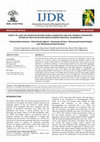Papers by Mohammad Ismail Moqbal

International Journal of Development Research, 2019
Conventional farming system may cause physical and chemical soil degradation. Plant residue reten... more Conventional farming system may cause physical and chemical soil degradation. Plant residue retention can be used to improve soil aggregation and chemical properties. However, the effectiveness of plant residue retention in conventional farming (CF) system remains unclear. Therefore, we studied the influence of plant residue retention on the water-stable aggregates, mean weight diameter of water-stable aggregates, bulk density and soil chemical properties. Plant residue had a significant effect on the distribution of water-stable aggregates, with aggregates >4 mm and 2 mm being 10.3% and 15.4% higher with plant residue in combination with conventional farming (PRF) in 2018 than CF. Over time in 2018, the highest MWD was obtained in PRF plots, being on average 14.9% higher than in CF fields. In 2018, plant residue retention had significantly increased water content, which was 42.3% in PRF plots. In 2018, PRF and CF plots had 130.8 kg ha-1 and 102.8 kg ha-1 NO 3-N respectively. PRF had 21.5% more soil NO 3-N than CF plots. Using plant residue also increased soil P and K + levels as compare to CF. These results indicated that retention of plant residue can increase water-stable macroaggregates, MWD and improve soil quality.

Reinforced concrete structures are subjected to damage and deterioration during their service lif... more Reinforced concrete structures are subjected to damage and deterioration during their service life because of exposure to many types of environmental influence. These damages or deterioration can reduce the performance and intended function of the structure. On several occasions structural failures are closely linked to the corrosion of steel reinforcement in concrete. Information about the current practice to prevent and protect corrosion of reinforcement in Malaysia is fragmented and hard to acquire. Local standard for corrosion treatment technique is not available. Each concrete repair organizations normally have their own approaches in solving corrosion problems. This has made it difficult for regulatory agencies to plan and implement an effective corrosion management system in the country. This paper presents the results of an industry survey concerning the awareness of local professionals toward reinforcement corrosion protection and prevention. The respondents were profession...
The objective of this study is to evaluate concrete compressive strength with inclusion of Local ... more The objective of this study is to evaluate concrete compressive strength with inclusion of Local Prepackaged Polymer-Modified Cementitious Mortar (PPMM) as a new modifier. 18 ordinary Portland concrete (OPC) cubes size 100 mm were prepared and cured according to ASTM C192 and a total of 180 polymer-modified concrete (PMC) cubes 100 mm size were prepared and cured according to JIS A 1171:2000 and JIS A 1171:2000 modified. The inclusion of PPM varies from 5% to 25%. From this research, the compressive strength of PMC produce has significantly increase compare to OPC. The PMC specimens which being cured according to JIS A 1171:2000 modified has recorded the maximum strength.
Construction and Building Materials, 2015
Methyl methacrylate performs effective retarder additive for polymer concrete in room ambient of ... more Methyl methacrylate performs effective retarder additive for polymer concrete in room ambient of 30 ± 2°C. Retarder additive of methyl methacrylate could improve properties of polymer concrete. Retarder additive of methyl methacrylate was not affected curing process of polymer concrete.

ICGSCE 2014, 2015
This paper discusses the feasibility of using an agricultural waste called palm oil fuel ash (POF... more This paper discusses the feasibility of using an agricultural waste called palm oil fuel ash (POFA) as micro-filler in polymer concrete. As a cellulose waste material, such potential of POFA is often neglected since it tends to uptake excessive resin during the mixing process. Hence, the filler characterization was involved in this study to investigate the potential of POFA become as micro-filler in polymer concrete. The filler characteristics of unground and ground POFA (UPOFA and GPOFA) were examined under microstructural examination, which included particle size analyzer (PSA), morphology image, and termogravimetric 41 and differential thermal analyses (TGA and DTA). A total of ten mix designs of polymer concrete were employed for flowability and compression test. Then, the workability and strength of polymer concrete were investigated after incorporating two types of filler with different filler content. Two major outcomes had been achieved. Firstly, the filler had their physical features significantly changed after physical surface modification. Secondly, finer filler had given superior workability and compressive strength. In conclusion, the agricultural waste of POFA can be incorporated as micro-filler in polymer concrete after being physically modified and mixed with the appropriate mix design to obtain superior mechanical properties.
Applied Mechanics and Materials, 2014
ABSTRACT
This research was to investigate the possibility to use paper sludge and palm oil fuel ash (POFA)... more This research was to investigate the possibility to use paper sludge and palm oil fuel ash (POFA) in manufacturing of construction product. 60 cubes were tested to determine the compressive strength of mixes with different mix proportions. The optimum water/sludge ratio and high-range water-reducer admixture percentage were also determined. Mix with suitable compressive strength was chosen to carry out the water absorption test. Study shows that paper sludge and palm oil fuel ash mix with cement can be used to make brick that comply strength requirement of BS 6073.

Reinforced concrete structures are subjected to damage and deterioration during their service lif... more Reinforced concrete structures are subjected to damage and deterioration during their service life because of exposure to many types of environmental influence. These damages or deterioration can reduce the performance and intended function of the structure. On several occasions structural failures are closely linked to the corrosion of steel reinforcement in concrete. Information about the current practice to prevent and protect corrosion of reinforcement in Malaysia is fragmented and hard to acquire. Local standard for corrosion treatment technique is not available. Each concrete repair organizations normally have their own approaches in solving corrosion problems. This has made it difficult for regulatory agencies to plan and implement an effective corrosion management system in the country. This paper presents the results of an industry survey concerning the awareness of local professionals toward reinforcement corrosion protection and prevention. The respondents were professionals working with consultants, contractors, suppliers and research institutions. The results indicate that common methods of corrosion prevention are surface treatment and improvement in concrete technology, while patch repair and chloride removal are frequently used for treating corrosion. In general, the level of awareness among professionals on common methods of corrosion protection and prevention is considered satisfactory. However the awareness on modern and high technology methods in treating corrosion are still weak and need to be enhanced. The solar energy approach in preventing and protecting reinforcement corrosion was not implemented in Malaysia.
Surface Review and Letters, 2015









Uploads
Papers by Mohammad Ismail Moqbal